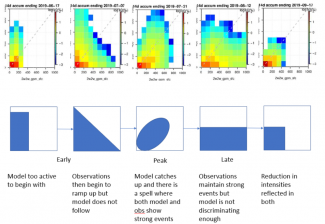Marion Mittermaier’s visitor project focused on developing a METplus use case for the Grid-Diag tool, which creates histograms for an arbitrary collection of data fields and levels. Marion used the Grid-Diag tool to investigate the relationship between the forecasted and observed precipitation accumulations for GloSea5, the UK Met Office ensemble seasonal prediction system and how the relationship evolved over time. The project is a sub-task of a larger body of work that uses several METplus capabilities with the objective of exploring the predictability of dynamical precursors of flooding in the Kerala region of India, a region that experienced severe flooding in successive monsoon seasons between 2018 and 2020 (see Figure).
Marion was surprised to find the level of agreement between the forecast and observations was very high, even without any form of hindcast adjustment. The Grid-Diag tool has shown that it can provide very useful and swift analysis of the associations between variables.
Often, other opportunities for collaboration present themselves on visits, and sometimes simple in-person communication can lead to a greater understanding of the models and/or software and tools developed at the DTC, which was definitely the case during Marion’s visit in August 2022.
METplus’s lead software engineer, John Halley Gotway “really enjoyed brainstorming novel applications of the TC-Diag tool with Marion, and doing so face-to-face through the DTC visitor program made for a very fruitful collaboration! Getting direct and detailed feedback about METplus from engaged scientists really helps inform future directions.”
Marion’s visit also provided her with an opportunity to learn about and explore a relatively new METplus tool, Multi-variate MODE (Method for Object-based Diagnostic Evaluation), which provides the capability to define objects based on multiple fields. Marion commented that “I’ve now successfully processed 6 months’ worth of forecasts using the complex use case. The analyzing process commences now, but it’s pretty cool to have come this far. Mountains of output have been generated. I wouldn’t have been able to do this without the time [Tracy] offered to walk me through it and I want to thank [Tracy] again. I can’t begin to say how valuable the visit last summer was. The time I spent with [Tracy], even though it was only an hour or two, was some of the “gold dust” that one hopes to find on these trips. It might not have been at the very top of my list of objectives for the trip but it has certainly contributed to making it the most productive trip in terms of “figuring stuff out” that I’ve learned. It’s proof that the visitor program does work but it wouldn’t work without all the people who are willing to give up their time to speak to us. That session made a very significant “penny drop” in my brain about METplus in a lot of ways. It’s like something clicked.”
The benefits from these visits go both ways. Tracy Hertneky, one of DTC’s scientists commented, “It was lovely to meet and work with Marion, even in the brief time spent guiding her through METplus and in particular, the complex and relatively new Mulit-variate MODE use case, which ingests 2+ fields to identify complex ‘super’ objects. I was happy to share my knowledge and expertise with her as I feel that these connections are one of the most valuable aspects of our work. As the multivariate MODE tool is enhanced, Marion and her colleagues may even be able to test the tool and provide valuable outside feedback on its usage.”
